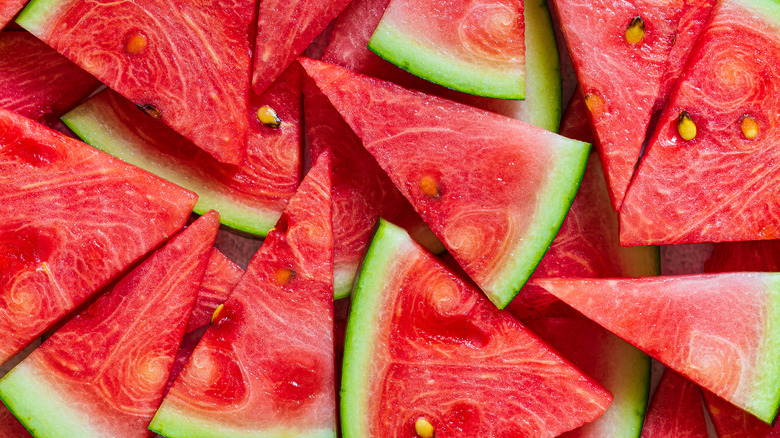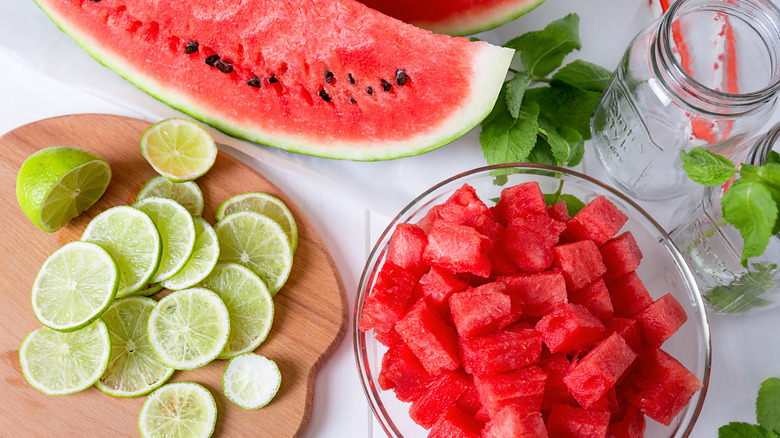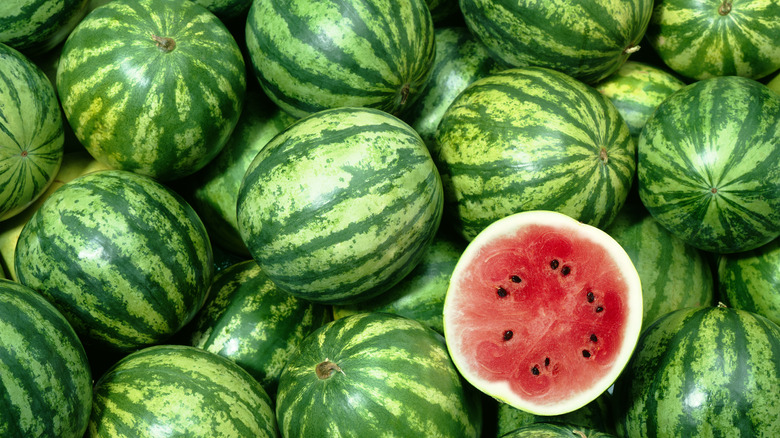How To Sweeten A Slightly Bland Watermelon
There's nothing quite like biting into a cold slice of watermelon bursting with sweet, syrupy juice on a hot summer's day. But, not all watermelons have that luscious saccharine flavor — some are disappointingly dull and, frankly, don't taste like much at all. But you don't have to settle for a lackluster watermelon, since there's an easy way to uplift its flavor.
Watermelons can actually be sweetened, and one quick way to do so is to top them with salt. Adding a sprinkle of salt to watermelon is a long-time Southern tradition, because salt has the ability to mask bitter or bland flavors and highlight sweeter ones instead.
This is why salt is often used to subdue the sharp bite of leafy greens such as kale and cabbage, and why it's added to desserts to intensify the sweetness. As a bonus, salt can pull the water packed inside a melon to its surface, making it juicy as well as sweet. You will also get an added boost of hydration as salt is packed with electrolytes that can fuel your body.
However, one thing to bear in mind is that salt won't just magically alter the flavor of the entire melon: It will only make the area that it directly touches taste sweeter. This is why it's best to use coarser and flakier varieties of salt that can cover a larger surface area of the fruit, to ensure that you get a burst of sweet juice in each mouthful.
Other ways to add flavor to a lackluster watermelon
Salt aside, there are several other ingredients that can save your mediocre watermelons. If sweetness is what the fruit lacks, there's always the option of dusting it with some sugar, drizzling it with condensed milk, or topping it with honey. The tang of lemon juice can also uplift the fruit's flavor, as can salty, spicy, and citrusy seasonings such as Tajín. Alternatively, you could eat the watermelon alongside a salty side dish to bring out its sweetness — think saline cheeses such as feta.
You don't have to use just one ingredient, either — try a combination of several to truly revive a drab watermelon. For instance, you can coat the sliced fruit in a layer of lemon zest, and then sprinkle sugar as well as herbs such as mint on top. This will give the fruit some brightness along with a sweet and tangy flavor.
It's also worth noting that you don't always have to eat a bland slice of melon. Consider turning it into juices and smoothies or even make it into a cold gazpacho and add vegetables and aromatics to amplify its flavor. You could also pair watermelon with alcohol, turning it into frozen margaritas, sangrias, and slushies with simple syrup and a medley of other fruits and spirits.
Telltale signs of a bland watermelon
There are several reasons why a watermelon may be bland. It could be a lack of sunshine that ultimately yields a dull crop, or the absence of seeds, which reduces sweetness. The culprit could also be the time of harvest: Watermelons don't ripen once they are plucked, so if they are harvested too early, the unripe fruits will be fairly flavorless.
Luckily, there are certain signs that you can look out for in order to choose the tastiest watermelons at the store. For instance, you can determine a watermelon's state of ripeness by its appearance or the sound that it makes when you knock it. Unripe melons will have a glossy sheen and will make a dull sound, whereas ripe ones will have a darker appearance and will make a deep and rounded sound.
Another indicator is webbing or sugar spots, which are the vein-like marks from where sugar seeps out of a watermelon. Look for melons with larger webbing as this means that they will have more sweetness. You should also look for any large discolored patches known as field spots. If the fruit has whitish spots, the flesh inside will be dull or bland. On the flip side, if it has an orange or deep yellow hue, the melon will be packed with a sweet flavor. Finally, a sweet watermelon will also weigh heavier due to a higher water content, so stay away from one that feels too light.



